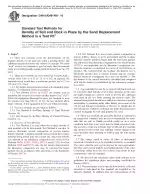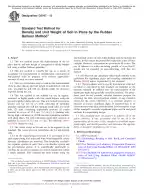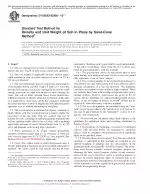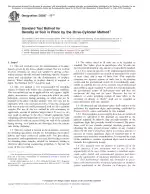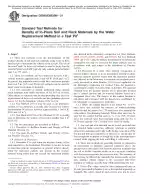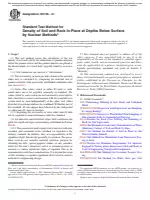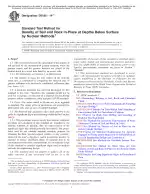ASTM D4914/D4914M-16 PDF Download
Standard EN SampleStandard Test Methods for Density of Soil and Rock in Place by the Sand Replacement Method in a Test Pit
Also Known As:
ASTM D4914/D4914M-16 is a standard used to determine the density of soil and rock in place by the sand replacement method in a test pit. These test methods are typically employed in construction projects for earth embankments, road fills, and structure backfill. They can be used to assess the quality and density of compacted materials to ensure that they meet the specified standards or requirements.
The test methods described in this standard can be applied to various materials, including natural soil deposits, aggregates, soil mixtures, and similar substances. However, it is important to note that the accuracy and reliability of the results depend on the competence of the personnel performing the tests, as well as the suitability of the equipment and facilities used. Compliance with the practices outlined in Practice D3740 is not a guarantee of reliable results, as testing depends on several factors.
These test methods specifically focus on pouring calibrated sand into a test pit to determine its volume. The term "rock" in the standard implies that the materials being tested typically contain particles larger than 3 inches (75 mm). The test methods are best suited for test pits with volumes ranging from 0.03 to 0.17 m³ (1 to 6 ft³) and materials with a maximum particle size of 75 to 125 mm (3 to 5 inches). For larger excavations or soil containing larger particles, Test Method D5030 is preferred. Smaller test holes can be evaluated using Test Method D1556 or D2167, with the option to use larger equipment when necessary.
The standard provides two test methods: Test Method A for determining the in-place density of total material, and Test Method B for determining the in-place density of the control fraction. Test Method A can also be used to determine percent compaction or percent relative density, provided that the maximum particle size in the in-place material does not exceed the maximum particle size allowed in the laboratory compaction test. Test Method B is used when the in-place material contains particles larger than the maximum size allowed in the laboratory compaction test or when Practice D4718 is not applicable. In Test Method B, the material is divided into a control fraction and an oversize fraction, and the dry density of the control fraction is compared to the established dry density(s) from laboratory compaction tests.
The materials that can be tested using these methods should be excavatable with hand tools and have voids or pore openings small enough to prevent the calibrated sand from entering. The material should also possess sufficient cohesion or particle interlocking to maintain stable sides during excavation and pouring of the sand. These test methods are generally not recommended for soft or friable materials or materials in a water condition that allows seepage into the hand-excavated hole. The accuracy of the tests may be affected by materials that deform easily or undergo volume changes.
Finally, the standard sets guidelines for significant digits and rounding of observed and calculated values, following the practices outlined in Practice D6026. The procedures used in this standard represent the industry standard for data collection, recording, and calculation. However, it is important to consider material variation, the purpose of obtaining the data, special purpose studies, and the user's objectives when determining the appropriate number of significant digits for reported data.
| Descriptors | in-place density, unit weight, test pits, sand replacement method, particle size, acceptance test,Rocks,Soils,Acceptance Testing,Density and Relative Density,MassCOMMA Volume and Weight,Particle Size Distribution,Soil Test |
| ICS Codes | 93.020 - Earthworks. Excavations. Foundation construction. Underground works |
| Language(s) | English |
| File Size | 440.3 KB |

